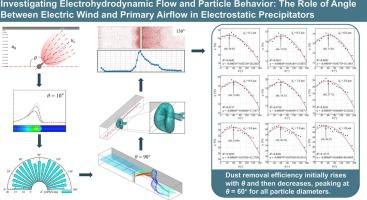Investigating electrohydrodynamic flow and particle behavior: The role of angle between electric wind and primary airflow in electrostatic precipitators
IF 4.6
2区 工程技术
Q2 ENGINEERING, CHEMICAL
引用次数: 0
Abstract
An integrated numerical model is proposed to investigate the influence of the angular difference (θ) between the primary airflow and ionic wind on flow patterns, particle transport, and deposition in electrostatic precipitators (ESPs), particularly in comfigurations with discharge needles. The model, implemented in ANSYS Fluent v19.3.0 with the RNG k-ε turbulence closure and Q-criterion vortex analysis, incorporates the electric body force obtained by solving the electric field equations. The results indicate that θ exerts a much stronger influence on ion charge density than on electric field strength. As θ deviates from 90°, the diffusion of ion charge density increases. For θ < 90°, the enhanced ion charge density facilitates earlier particle charging, thereby improving particle removal efficiency. Altering θ also alters the isovortex surfaces, forming vortex rings and large-scale counter-rotating vortex pairs, which generate helical gas flow that affects particle transport and deposition. Particle removal efficiency first increases with θ and then decreases, peaking at θ = 60° for all particle diameters. Moreover, increasing θ or particle diameter results in more regular deposition patterns on the collecting surface.

研究电流体动力流动和粒子行为:电除尘器中电风与一次气流夹角的作用
提出了一种综合数值模型,研究了初级气流和离子风之间的角差(θ)对静电除尘器(esp)中的流动模式、颗粒输运和沉积的影响,特别是在有放电针的配置中。该模型在ANSYS Fluent v19.3.0中实现,采用RNG k-ε湍流闭包和q准则涡分析,结合求解电场方程得到的电体力。结果表明,θ对离子电荷密度的影响远大于对电场强度的影响。当θ偏离90°时,离子电荷密度的扩散增大。当θ <; 90°时,离子电荷密度增强,有利于粒子提前充电,从而提高粒子去除效率。θ的改变也会改变等涡面,形成涡环和大规模的反向旋转涡对,从而产生影响粒子输运和沉积的螺旋气体流动。颗粒去除效率随θ增大先增大后减小,在θ = 60°处达到峰值。此外,增加θ或颗粒直径会导致收集表面上更规则的沉积模式。
本文章由计算机程序翻译,如有差异,请以英文原文为准。
求助全文
约1分钟内获得全文
求助全文
来源期刊

Powder Technology
工程技术-工程:化工
CiteScore
9.90
自引率
15.40%
发文量
1047
审稿时长
46 days
期刊介绍:
Powder Technology is an International Journal on the Science and Technology of Wet and Dry Particulate Systems. Powder Technology publishes papers on all aspects of the formation of particles and their characterisation and on the study of systems containing particulate solids. No limitation is imposed on the size of the particles, which may range from nanometre scale, as in pigments or aerosols, to that of mined or quarried materials. The following list of topics is not intended to be comprehensive, but rather to indicate typical subjects which fall within the scope of the journal's interests:
Formation and synthesis of particles by precipitation and other methods.
Modification of particles by agglomeration, coating, comminution and attrition.
Characterisation of the size, shape, surface area, pore structure and strength of particles and agglomerates (including the origins and effects of inter particle forces).
Packing, failure, flow and permeability of assemblies of particles.
Particle-particle interactions and suspension rheology.
Handling and processing operations such as slurry flow, fluidization, pneumatic conveying.
Interactions between particles and their environment, including delivery of particulate products to the body.
Applications of particle technology in production of pharmaceuticals, chemicals, foods, pigments, structural, and functional materials and in environmental and energy related matters.
For materials-oriented contributions we are looking for articles revealing the effect of particle/powder characteristics (size, morphology and composition, in that order) on material performance or functionality and, ideally, comparison to any industrial standard.
 求助内容:
求助内容: 应助结果提醒方式:
应助结果提醒方式:


